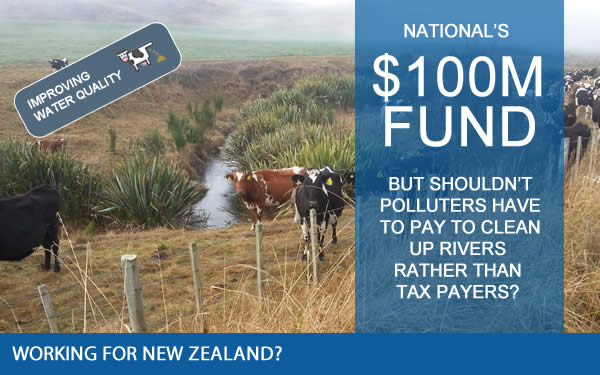National’s latest water plan to spend $100m on buying sensitive land next to rivers won’t have as much impact on our water quality as lower dairy prices will, and certainly not as much as decent regulation would.
Their plan sets up a $100m fund to buy land next to sensitive waterways. They will also require all dairy farmers to fence and plant their rivers by 2017, and over time make the lowland sheep and beef farmers do it too. Let’s look at the second part of the policy first.
Dairy Farmers doing it anyway
The irony of this announcement is that dairy farmers were doing it anyway, which is why the announcement seems to have got the backs up of Federated Farmers. Under the Sustainable Dairying: Water Accord all Fonterra farms have to have their waterways fenced off by 2017. National have pointed out that other dairy companies are not signed up to the accord – so this will drag the laggards up to Fonterra’s level. It will also be regulated and backed up with fines, rather than a voluntary agreement. So a small step forward, but hardly a revolutionary leap.
Still cattle in our water
But don’t think for a moment that all cattle will be kept out of waterways. For starters this only applies to permanent rivers and streams; ephemeral or temporary streams (e.g. they only run in winter and spring) don’t apply. Nor do the roughly 4 million cows kept on beef farms. Nor do – and here’s the really tricky part – dairy cattle when they are being kept on sheep and beef farms (this is usually over winter when they are not milking). So there is a long way to go before we won’t see any more cows standing (and potentially crapping) in our streams. National have made a vague promise to sort this out, but they have no plan to do so.
What will $100 million buy us?
Now to the $100 million fund. Firstly, what will it achieve? That kind of money does not buy you a lot of land, especially spread over ten years, even if regional councils are chipping in too.
Farmers can achieve more themselves. As we go around the country, we see responsible farmers retiring this sort of sensitive land next to rivers and lakes themselves. Usually they are dairy farmers, so have the cash to make these sorts of investments. Many of them report that their productivity actually rises when they retire this sort of land, as land gets stabilised, cattle aren’t getting caught in bog, and birdlife stay off their pasture.
Rather than buying land, the money might be better spent working with sheep and beef farmers to fence and plant their waterways, so that they can see the benefits that dairy farmers are already experiencing. Or as Forest and Bird have pointed out, the money could be invested in advising farmers what they can do on their own land (including retiring the bits next to waterways).
Who is paying?
Another question is who is paying for this fund? The answer is you and me – taxpayers and ratepayers will both have to chip in. That really means we are paying twice – firstly in our waterways being degraded, and secondly to clean it up. Why shouldn’t polluters pay to fix the damage they have done? Why is it up to the people who have done nothing wrong to pay up? This is the sort of activity that the irrigation levy proposed by Labour and the Greens would potentially be spent on. In our view we need to sort out who owns water, create a way of trading water use rights, and charge all users a resource rental, which could fund this activity.
What would be better? Some decent regulation
We will not solve our water quality problems by buying our way out of them. We need to change the way we farm. This change would be helped along by putting in place tough limits on water quality, which National have currently failed to do. As we found by working with a panel of scientists, there is nothing to stop having an aspiration of swimmable rivers, rather than National’s bottom line of wadeability. But the most important thing is that all of our waterways are maintained or improved from this point on, and that should be clearly measured and monitored (for example using the Macroinvertebrate Community Index or MCI).
This is possible to do: they have done it in Otago. When they asked communities what they want, they said to swim and gather food in their rivers. So instead of letting every community battle that out for themselves through collaborative processes, they just set limits accordingly. It can really be that simple.
This does not have to mean the end to dairy farming in New Zealand. It does mean we need to explore ways of farming less intensively, while maintaining our profit. This could potentially be a huge opportunity for New Zealand to lead the world in producing sustainable, high quality food.

